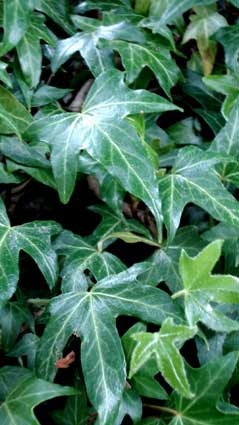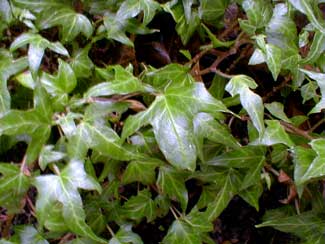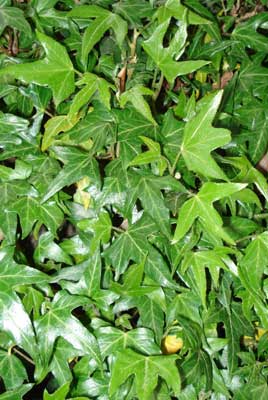
Needlepoint Ivy
aka, Birdsfoot Ivy
or, Arrowleaf Pot Ivy
"His affections, like ivy, were the growth of time."
-The Strange Case of
Dr. Jekyll & Mr. Hyde,
by Robert Louis Stevenson,
1850-1994
Dr. Jekyll & Mr. Hyde,
by Robert Louis Stevenson,
1850-1994
Needlepoint Ivy is perfect for hanging baskets or other containers, or as a groundcover or as a clinging vine for a stone wall. After a year or two of setting down roots, it will become vigorous in its spread.
 Spread of a single small start will easily reach six or eight feet, though it is quite easily kept smaller. If not restrained with annual trimming back to a central root, then the creeping vines will root themselves at intervals to continue their spread, potentially without limit.
Spread of a single small start will easily reach six or eight feet, though it is quite easily kept smaller. If not restrained with annual trimming back to a central root, then the creeping vines will root themselves at intervals to continue their spread, potentially without limit.Wherever the the vines root in soil, they can be clipped free to make new starts. However, the aereal roots that attach them to stones, walls, or trees are not as likely to become real roots, though these can be helped along with rooting hormone.
It will climb trees to at least six feet (eventually much, much higher) if opportunity arises, doing them little to no harm (see the Hedera helix var minima page for a discussion of ivies cimbing trees). Aereal roots do not really penetrate bark & are not causing injury. A potential for blocking light occurs only if the vines spead to the outer edges of the limbs, which needlepoint is not inclined to do, & for samplings there's a slight risk of strangulation. But when restricted to the bark of a mature tree, there will be no injury.
It's sometimes called a Pot Ivy because it does so well in containers. It is even one of the varieties recommended as best for topiary purposes because of its leaf density, & for being trainable over shaped wire frameworks, responding favorably to skillful pruning. As a very low-growing creeping vine it is even recommended as an alternative to lawns, though of course not the sort of lawn one runs about on or for playing croquet.
Like all English Ivy it is somewhat deer resistant because mildly toxic, the leaves & especially the berry pulp containing saponins that have a bitter taste to squirrels & ruminants, & an irritant effect in the mouth. The leaves & berries also contain hydrocyanic acid, so are about as toxic the leaves of native chokecherries. Severe symptoms are so extremely rare as to be no practical worry, but if large quantities of the leaves & berries could be ingested, it has the potential to be life-threatening.
This limits the amount of foraging mammals safely perform amidst ivy, but does not stop foraging altogether. Despite the poor taste & mild toxicity, many wild & domestic ruminants nevertheless eat it without noticeably ill effect, or with minor effects from which they swiftly recover, & goats in particular like it. It is a preferred food item for pet walking-stick bugs.
Saponin-induced diarrhea serves ivy differently when the berries are eaten by birds, in that the seeds are pooped out more quickly, while the seeds are still viable. Birds are thus used by the plant to spread seeds into woodland areas. The introduced English Sparrow & European Starlings eat the berries with abandon & distribute the seeds without ill effect to themselves, having evolved within ivy's natural range; but songbirds native to North America have more trouble with resulting illness, as reported by Barnea et al in Biochemical Systematics and Ecology, 21:421ff, 1993.
There is therefore some worry that when ivy becomes invasive to native woodlands, it suppresses bird populations as well as displacing native flora. Fortunately it is the large forms of ivy, not dwarf needlepoints, that are notably invasive. When grown in shady areas, needlepoint ivy almost never flowers or fruits, which is in general a good reason to restrict ivy to shady locations, its flowers being ornamentally inconsequential anyway. If it does develop an upright branch in preparation for flowering, such branches should be trimmed away to discourage fruiting.
'Needlepoint' is often given as a cultivar name, but it really describes a group of cultivar types ranging in size from one-third that of regular English ivy to smaller than one inch like 'Midget' (aka 'Miniature Needlepoint') or 'Minigreen.' Most have ivory veining, & there are also variegated needlepoints.
 This group of cultivars has three to five sharply pointed lobes; ours has the full five. Such needlepoint ivies are additionally called Hedera helix forma digitata or Digitate Ivy on the premise the five pointed lobes resemble fingers of a hand; & this is synonymous with Hedera helix forma sagittifolia, meaning Arrow Leaves, occasionally given in the manner of a cultivar name as 'Sagittifolia' or 'Sagittaefolia.'
This group of cultivars has three to five sharply pointed lobes; ours has the full five. Such needlepoint ivies are additionally called Hedera helix forma digitata or Digitate Ivy on the premise the five pointed lobes resemble fingers of a hand; & this is synonymous with Hedera helix forma sagittifolia, meaning Arrow Leaves, occasionally given in the manner of a cultivar name as 'Sagittifolia' or 'Sagittaefolia.'The bewildering array of cultivar names do not always indicate separate Needlepoint cultivars. Many are only alternate names from different sources, though some catalogs will list for sale sundry look-alikes that are not actually distinct. Thus we find that 'Caenwoodiana' is synonymous with 'Digitata,' 'Sagittifolia,' & 'Pedata.' In Germany it is called 'Koeniger's Auslese,' & occasionally called such in English catalogs. It means Koeniger's Choice, with an inherent allusion to the best grapes of a harvest year, drawing a comparison between grape ivy & H. helix.
We obtained our Needlepoint starts with no cultivar names attached, but the one shown in the first two photos looks like 'Caenwoodiana,' or the presumedly improved version called 'Starling.' Ours is not quite so small as 'Midget,' but is the size of 'Starling' & 'Caenwoodiana' with the same arrowhead appearance, narrower than most varieties of Needlepoint Ivy.
Because 'Caenwoodiana' is so commonly offered under sundry names, odds are in favor of ours being that specific cultivar. 'Caenwoodiana' often (not invariably) has three forward-pointing lobes & two backward pointing laterals, as in the first photo above. Yet another section of the exact same plant, as shown in the second photo, has laterals on the needlepoint ivy shown in the second photos point outward.
Plus there are less common cultivars in the 'Needlepoint' subgroup which I've not even considered, & variations in the leaves from plant to plant, or even from stem to stem, sufficiently diverse to make identification mostly guesswork. So when in doubt 'Needlepoint' is the fall-back all-purpose name.
Needlepoint varieties are also called Birdsfoot, Birdfoot, or Bird's Foot Ivy, because the leaf shape resembles tracks left by chickens.
Ivies best like partial to full shade. But it tolerates full sun too, needing more frequent watering until safely established. It thrives in most reasonable soil conditions except wet & poorly draining. It thrives in droughty shade as so few plants do, so is very useful for greening-up some harsh locations, though in the toughest ground it will be even slower to start spreading.